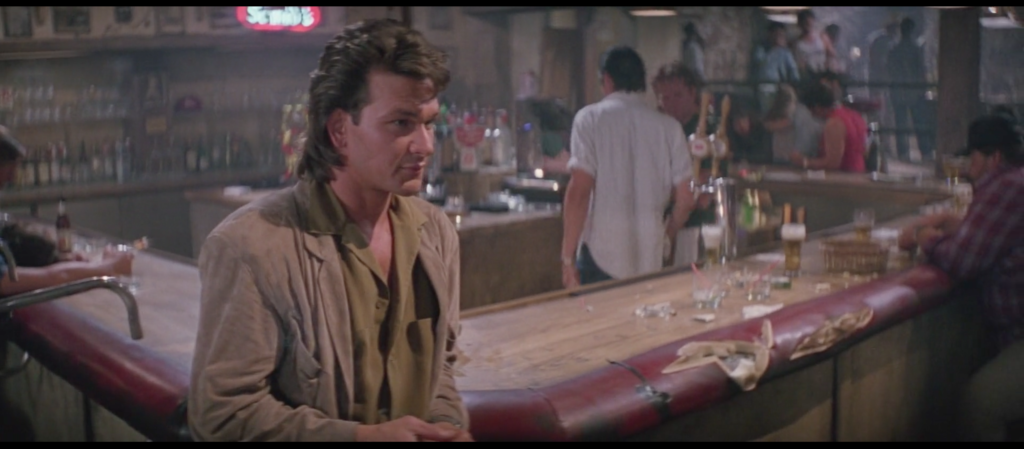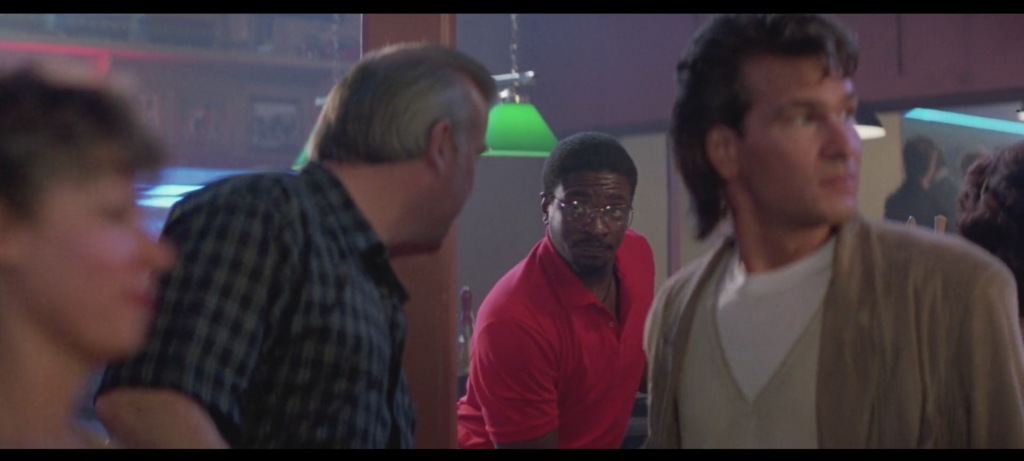Posts Tagged ‘bartenders’
166. Details
June 15, 2019As a visual text, Road House is a chest of wonders. Look at this shot from early on in the film, on the night when Dalton first visits the Double Deuce. There he is at his familiar post, in his familiar shapeless beige jacket. There’s Pat McGurn and The Bartender Who Must Not Be Named behind him, conferring about whatever a sister-son and a working stiff who both happen to have the same job at the same place might confer about. (“So what’s it like working with Exene after the divorce? And this Mortensen kid she’s with, is he cool? Because he seems cool.”)
To the left is a power drinker, passed out on the bar; from this we can infer that Pat, ever conscious of the needs of his uncles liquor distributorship, refuses to cut off even the most obviously inebriated patrons, and most likely pressures the Nameless One into doing the same. Given the behavior of the comparatively sober customers, what does he have to lose, really.
To the right is a detail I’m just now noticing: the dry spongy exposed foam of the bar’s padding, chipped and peeled and torn away by the half-hearted vandalism of the drunk and the fixated. Back in the “everything is padded” days of restaurateurship, such artifacts of idle destructiveness were visible everywhere. I haven’t sat on an upholstered seat at an upholstered table in many a long year, but I can feel the satisfaction of ripping away a chip of covering and pulling at the porous brown stuffing underneath like my hands are doing it right now instead of typing this sentence. For all that Road House is rightfully dinged about its lack of realism, even as regards bar furniture specifically (the price of replacement tables alone from the fight about to ensue would put a normal establishment out of business), that’s some real shit.
And to the right of that? Why, that familiar fellow is none other than Brad Welsey’s own Tinker. Has he come to chat with fellow Wesleyans Pat and Morgan about the art of the goon over a few drinks when they have a moment to spare during their busy evenings of stealing from the cash register and erupting into violence over the slightest provocation? Is he additional muscle to make sure Mr. Wesley’s liquor flows without impediment? Is he simply a fan of the Jeff Healey Band? At another time during this sequence he’s seen chatting up some lovely lady; is the Double Deuce his fern bar, his Regal Beagle? Is this Tinker Tinder?
I’m reminded here of the extensive making-of documentaries included in the Lord of the Rings extended edition sets. I don’t remember the exact wording offered by the heads of the various costume and design and set departments regarding their lunatic attention to detail. I do remember the gist of it, though: They would produce intricate designs for the insides of garments and scabbards or for swords that would only be seen from a distance or for rooms no one would even enter or what have you not because the audience would see them, which they knew they wouldn’t. They did so because they were creating a world for the entire production to inhabit, not just the viewer. A cast or crew member who spent a few seconds admiring the embroidery of their breeches would be that much closer to convincingly conveying the reality of a world of orcs and elves and hobbits and magic rings. Look at the shot above, really look at it, and tell me if he war between the world’s most famous bouncers and the maniac mall devleoper who keeps their bar in Jim Beam seems as much of a stretch as it did before.
018. Keith David
January 18, 2019This is Keith David. In 1982, he played Childs in John Carpenter’s The Thing. Childs is the primary antagonist for the main character, R.J. MacReady, played by Kurt Russell. I mean, everyone is everyone’s antagonist, but Childs is the person who’s the most openly suspicious of MacReady and hostile to the way he sort of naturally slides into a command position. It’s too much to say the two men must learn to work together to have any hope of defeating the shape-shifting alien that has infiltrated their remote Antarctic outpost, since there’s no learning involved, but they must work together, that’s for sure. The extent to which they do or don’t is, in the end, the final question asked by the film. David plays the character like a pot of water set to boil at any moment; his chemistry with the less demonstrative but no less gruff and argumentative MacReady is considerable, and essential to the success of the movie, which is one of the greatest horror and science-fiction films ever made.
In 1988, David reunited with carpenter for They Live, in which he played Frank. Frank is the primary antagonist for the main character, Nada, played by “Rowdy” Roddy Piper. Again, everyone is everyone’s antagonist in this film, another stone sci-fi/horror classic about distrust and paranoia in a world where alien invaders can look just like you and me. Beneath the anti-consumerist, anti-capitalist, anti-cop, anti-corporate-media agitprop for which it has become justly famous, They Live takes The Thing‘s survival-horror cabin-fever claustrophobia and simply expands it outward, until the entire planet is the remote outpost on which the last sane men and women are trapped. Having slipped on a specially treated pair of sunglasses that enable him to see the true faces of the alien overlords and the mind-numbing subliminal messages they’ve implanted in every TV screen, billboard, and printed page, Nada is one such sane man, but he can’t fight back alone. He needs Frank, a guy even bigger and tougher than himself whom he met while they made just-above-starvation wages at a construction site, to put on the sunglasses and see for himself, so they can join forces and fight the real enemy. Frank, understandably, thinks Nada is out of his mind. The only way he’ll wear the damn glasses is if he is beaten up badly enough to literally be unable to stop Nada from putting them on his head. This is what happens, during an ugly, sloppy, seemingly endless one-on-one brawl in an alleyway that lasts for six full minutes. It’s just Roddy Piper and Keith David whaling on each other, over and over, for roughly the length of “Hey Jude.” In the end, Frank is made to see the truth, and the two combatants become allies. It’s one of the greatest fight scenes ever filmed.
In 1989, David joined director Rowdy Herrington and star Patrick Swayze for Road House, a film that is to men punching other men in the face and torso what the children’s book series Clifford the Big Red Dog is to big red dogs named Clifford, in which he plays Ernie Bass. Ernie is not a bouncer. Ernie is a bartender. He says “Whiskey’s running low.” I think maybe he says hello to Dalton at some point but I’m not sure. He does not fight anyone, at all, ever. Not one punch. Not even a raised voice. Who knows, though. Maybe he helps guard Jasper, Missouri from the forces of evil by Dalton’s side after the end credits roll. It’s possible, anyway. Why don’t we just wait here for a little while. See what happens.


